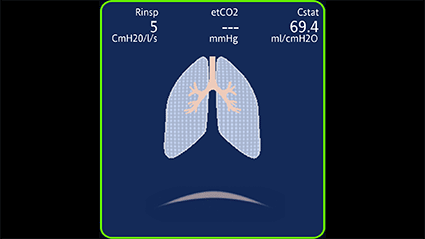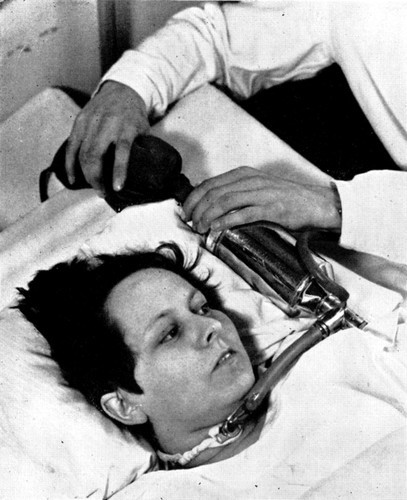COVID-19: Death by Ventilators? | The Triumphant Return of The H-H Inhalator
Could the mechanical ventilators routinely used on patients with symptoms of COVID-19 be directly killing them? A growing body of evidence says yes. Both the pressure and the pure oxygen are responsible for the damage caused by mechanical ventilators, which were first proven harmful in 1827 by French surgeon Leroy d’Etoille. Yet the use of these unnecessary and harmful interventions continue to this day.
 Is the use of mechanical ventilators on COVID-19 patients causing more harm than good?
Is the use of mechanical ventilators on COVID-19 patients causing more harm than good?In this article, I’ll present some of the evidence suggesting mechanical ventilators are harming patients and doing precisely the opposite of their intended use – reducing cellular oxygenation rather than increasing it. You’ll also learn about a miraculous emergency intervention called carbogen, which has been proven to cure pneumonia in 12 to 24 hours and was routinely used by firefighters, hospitals and rescue crews on emergency patients in the United States in the 1940’s.
This article is a call for hospitals to immediately replace their mechanical ventilators with HH-Inhalators, devices that produce and administer carbogen gas to patients, which will heal patients instead of harming them. Be sure to pass this article onto any doctors or nurses in your life so they can learn about carbogen and why mechanical ventilation is a public health disaster.
COVID-19 Controversy Surrounding Mechanical VentilatorsIn the early days of the COVID-19 pandemic, a dispute broke out among critical care and emergency physicians: Could the mechanical ventilators routinely used on COVID-19 patients (and not the virus itself) be the cause of ARDS (Acute Respiratory Distress Syndrome)?
Much of the debate was spurred by the impassioned pleas of the New York-based emergency physician Cameron-Kyle Siddell, who noticed from direct experience treating patients the harm being caused by mechanical ventilation.(1)
“This is the disease—Advanced Respiratory Distress Syndrome (ARDS)—that every hospital is preparing to treat. And this is the disease for which 100,000 Americans might be put on a ventilator. And yet, everything I have seen in the last 9 days [has] led me to believe that COVID-19 is not this disease, and that we are operating under a medical paradigm that is untrue. I don’t know the final answer of this disease, but I’m quite sure that a ventilator is not it.”
– Dr Cameron-Kyle Siddell
“I’ve talked to doctors all around the country and it is becoming increasingly clear that the pressure we’re providing may be hurting their lungs, that it is highly likely that the high pressures we’re using are damaging the lungs of the patients we are putting the breathing tubes in,” continued Siddell.(12)
Reports from Wuhan, Seattle and cities in Italy now suggest that placing patients on ventilators may not significantly improve their chances of recovery or survival at all.
“Contrary to the impression that if extremely ill patients with COVID-19 are treated with ventilators they will live and if they are not, they will die, the reality is far different,” Gillick said.
For decades it has been known that the use of mechanical ventilators themselves can cause pneumonia in patients. One team of scientists wrote that patients undergoing mechanical ventilatioin “are at significant risk of developing a secondary, ventilator-associated pneumonia (VAP).”(1)
An article from Live Science reported the following:
Patients with low blood-oxygen levels but few signs of distress or organ damage may not benefit from ventilation, according to researchers from Italy and Germany who submitted a letter published March 30 in the American Journal of Respiratory and Critical Care Medicine. In the letter, they described patients with these traits in Italy and Germany, noting that their lungs appeared relatively healthy as compared with COVID-19 patients with acute respiratory distress, a condition where the air sacs in the lungs fill with fluid.
Even if patients do develop acute respiratory distress, they may not benefit from ventilation either. The thick fluid clogging up the lungs “limits oxygen transfer from the lungs to the blood, even when a machine pumps in oxygen,” said Dr. Muriel Gillick, a geriatric and palliative care physician at Harvard Medical School. In this case, placing a patient on a ventilator could damage their lungs by introducing too much pressure into the organ, she said.
Modern doctors are observing what had been proven almost 200 years ago: Mechanical ventilation is a dangerous and damaging practice. In 1827, French surgeon Leroy d’Etoille demonstrated “that elevated air pressure could cause ruptured alveoli, emphysema, and tension pneumothorax.”(13) The elevated air pressure he describes is the same that’s routinely being used today on COVID patients with mechanical ventilators.
If mechanical ventilators are harmful, then why are they being routinely used on COVID-19 patients? In order to answer this question, it’s essential that we understand a bit about the history of mechanical ventilators. An essay from Harvard University in 2021 details the history of ventilators and how the disease ARDS emerged as a syndrome caused by the use of ventilator technology itself.(2) The story begins with the polio outbreak in Copenhagen in the early 1950s.
Ventilators Returned During Polio Outbreak in CopenhagenIn 1952, Polio struck the city of Copenhagen hard. The emergence of the Polio epidemic in the early 1950’s sparked the revival of a dangerous practice in medicine that had long been proven harmful: Positive-pressure ventilation. The Blegdam, Copenhagen’s only infectious diseases hospital, was quickly overrun with patients, and they needed a way to handle the tsunami of patients “desperately ill with respiratory insufficiency and impairment of deglutition, drowning in their own secretions.”
A closer look at the polio patients reveals that many had respiratory paralysis, where they basically stopped breathing. “Their bold solution was to manually ventilate patients by squeezing a rubber bag attached to a tracheostomy tube inserted through an incision just below the larynx,” reports a study published in The American Physiological Society in 2005.(10) “The logistical problem was solved by having a roster of 200 medical students who operated in relays. At the height of the epidemic, 70 patients had to be manually ventilated around the clock. The medical students worked 6- or 8-h shifts so that three or four shifts were needed in the 24 h.” One report states that 1,500 students in all took part in this activity with a total of 165,000 hours(16).
 Photograph of a patient being manually ventilated in Copenhagen during Polio Outbreak at The Blegdam.
Photograph of a patient being manually ventilated in Copenhagen during Polio Outbreak at The Blegdam.It’s important to note that no successful treatment by positive pressure ventilation given continuously over a long period had been reported by 1950(12). This is a great example of the dissociation that commonly occurs between scientific advancements and their application to clinical situations. Despite being proven ineffective and harmful long before, positive-pressure ventilation was chosen to deal with the onslaught of patients during the outbreak of Polio.
It’s important to note that the air administered to patients in Copenhagen in 1952 contained 50% nitrogen and 50% oxygen, which is significantly less damaging than the 100% oxygen administered under pressure to COVID-19 patients using mechanical ventilators. Perhaps the is explains why some patients died and some survived following manual ventilation.
Chief physician at the hospital Alexander Lassen (1900–1974) later admitted that they didn’t really know what they were doing. “Although we thought we knew something about the management of bulbar and respiratory poliomyelitis it soon became clear that only very little of what we did know at the beginning of the epidemic was really worth knowing”(21).
Mechanical Ventilators: A Public Health Disaster!One of the common features observed in COVID-19 patients in hospital settings is a rapid oxygen desaturation in the blood. The response by the medical industry has been to administer fentanyl which, prior to the COVID-19 outbreak, had been labelled “The most dangerous illegal drug in America”(55), then force oxygen into their lungs through the use of a mechanical ventilator. This practice suggests an alarming lack of understanding of human physiology and of history.
By forcing oxygen into the lungs of patients using a ventilator, carbon dioxide (CO2) gas is rapidly removed from the bloodstream and replaced by oxygen. This would be beneficial if carbon dioxide were actually a waste gas like it’s commonly claimed to be, however, and unfortunately, what’s taught to doctors and nurses in their medical training about the physiological role of carbon dioxide in the body is false. Without adequate carbon dioxide, the body cannot use oxygen. The key to understanding why lies a couple important concepts called The Haldane Effect and The Bohr Effect.
The Haldane Effect, first described by John Scott Haldane in the early 20th century, states that oxygenation of blood in the lungs increases the removal of carbon dioxide from the body. And The Bohr Effect, which is a mirror image of The Haldane Effect, shows us that without sufficient carbon dioxide in the body, the cells cannot use oxygen. By forcing oxygen into the lungs of COVID-19 patients using positive pressure ventilation, oxygen use becomes further impaired, making the situation worse.
“Do people know that our health depends on the level of carbon dioxide in the body?”– Dr Alina Vasiljeva and Dr David Nias Is Mechanical Ventilator-Induced Damage Being Blamed on COVID-19?
A mild case of the COVID-19 respiratory illness can include coughing, fever or shortness of breath, no different than the flu. In cases of severe COVID-19 the patient experiences pneumonia.
The symptoms of pneumonia reported in severe COVID-19 patients (ie damaged air sacs in the lungs) are identical to the damage caused by mechanical ventilators. Is this a coincidence? Or is the damage (and deaths) caused by the use of mechanical ventilators being blamed on the SARS-CoV-2 virus? Any doctors working directly with COVID patients who are reading this I’d love to hear your perspective.
Whatever the case may be, we may never know. What’s most important is finding a safe and effective replacement for mechanical ventilators.
It is an honor to introduce to you a miraculous medical intervention that was once commonly used in medicine but has now been forgotten. It’s safe, highly effective for many disorders, and is proven to cure pneumonia in 12 to 24 hours. Carbogen is the perfect remedy to use in place of mechanical ventilators in emergency medicine, especially for COVID-19.
The Return of The HH-Inhalator: Carbogen to the RescueCarbogen therapy is the medical administration of a mixture of around 5% carbon dioxide in either air or 95% oxygen to patients in emergency situations. Carbogen is useful in stimulating breathing and for promoting vasodilation in the body. Medical use of carbogen was investigated in the mid-twentieth century for a range of health issues including depression, neuroses, psychoses, dementia, arthritis, cerebral palsy, asthma, hiccups, and whooping cough.
The article Carbon Dioxide by the late Yandell Henderson, discusses the routine use of carbogen by rescue crews in the 1940s generated by a device called an H-H Inhalator. Treat a patient with pneumonia using an H-H Inhalator and a rapid recovery will be induced.
“A special form of apparatus, the H-H Inhalator, for the administration of a mixture of oxygen and carbon dioxide to asphyxiated patients was, therefore, devised and has been widely introduced. This treatment has been so successful that many thousands of these inhalators are now in use: several hundred, for instance, in metropolitan New York, and a number corresponding to the population in Chicago and other cities. The rescue crews of the fire and police departments, the gas and electric companies, and now also the hospital ambulances generally have them. At first a mixture of 5% carbon dioxide in oxygen was used, but 7% has proved even more beneficial. The value of this treatment is not merely for the saving of life, but also for the prevention of such postasphyxial sequelae as pneumonia, injury to the heart, and permanent nervous impairment. In many cases of brief but intense asphyxiation the patient is completely restored within an hour; he may then voluntarily and safely go back to work.”
– Dr Yandell Henderson
Rather than administering pure oxygen to patients using mechanical ventilators and reducing cellular oxygenation by purging the valuable CO2 from their bodies, Carbogen produced by H-H ventilators rapidly oxygenates cells, which is exactly what patients lacking oxygen need.
Pneumonia Cured in 24 Hours Using CarbogenOne of the well-known hallmarks of COVID-19 infection is pneumonia and the difficulty breathing (dyspnea) and inflammation-induced damage of the alveoli in the lungs. Severe COVID-19 is pneumonia, and a cure for pneumonia has been known for almost 100 years.
In the 1930s, Dr. Yandell Henderson reported to completely cure dogs with pneumonia in just 12 to 24 hours through the administration of carbogen.(https://www.advancedbuteyko.com/yandell-henderson-co2-carbon-dioxide.php). It worked on dogs, and on humans.
“Many cases of pneumonia have now been treated with inhalation of carbon dioxide in oxygen; and a special tent for this treatment is being introduced by Henderson and Haggard. It is believed by those who have used it that this treatment is decidedly superior to that with oxygen alone,” wrote Dr. Henderson.
ConclusionHistory and scientific evidence on the use of mechanical ventilators show us clearly that the administration of pure oxygen under pressure causes damage to patients – a fact once known yet forgotten. Let us take this as a reminder that when we refuse to learn from history, we do so at our own peril. The current disaster of mechanical ventilating COVID-19 patients to death has been wrought by our own ignorance is playing out now in emergency rooms worldwide.
A tried, tested and true medical intervention that should replace the use of positive pressure ventilation of pure oxygen is carbogen. The 5% carbon dioxide gas in 95% oxygen mixed by the HH-Inhalator was proven almost 100 years ago to rapidly cure pneumonia – the exact condition seen in severe COVID-19 patients. The evidence suggests a return to carbogen administration on COVID-19 patients and also in place of pure oxygen in all emergency situations.
This article is a call for the immediate replacement of the practice of mechanical ventilation with carbogen mixed and administered by the use of the HH-Inhalator.
The post COVID-19: Death by Ventilators? | The Triumphant Return of The H-H Inhalator appeared first on ENDALLDISEASE.



